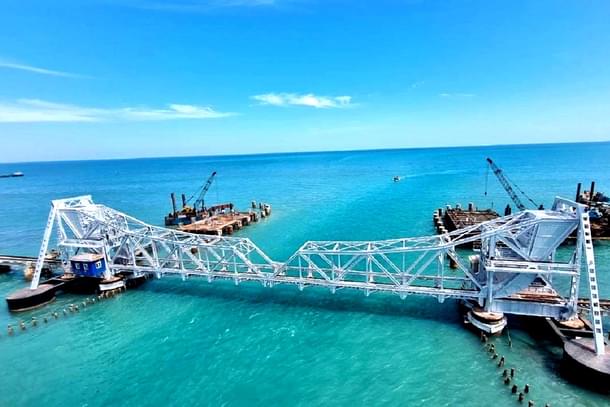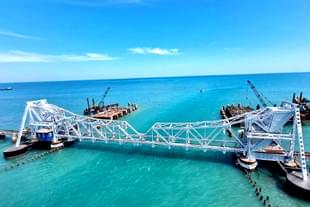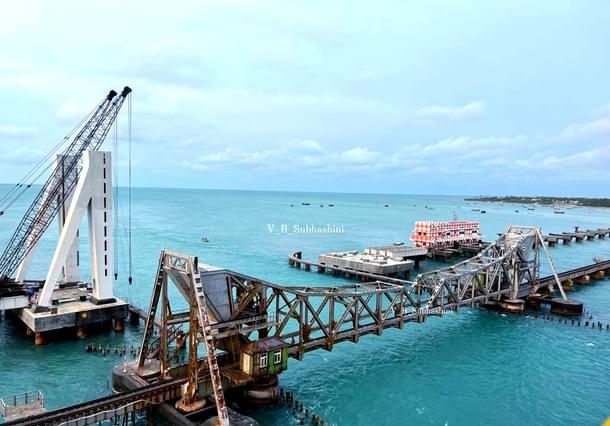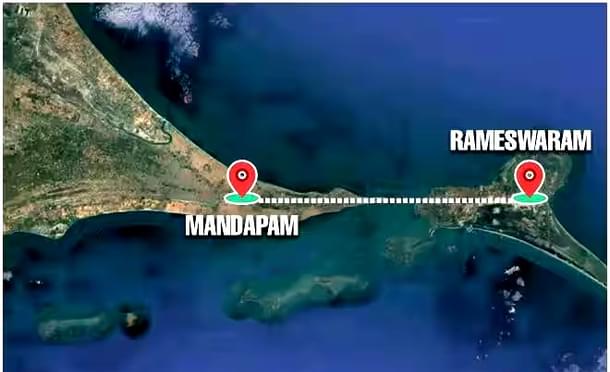Infrastructure
Onward To Completion: India's First Vertical-Lift Railway Sea Bridge Navigates Construction Challenges With Mechanical Ingenuity
V Bhagya Subhashini
Apr 10, 2024, 10:42 AM | Updated 10:40 AM IST
Save & read from anywhere!
Bookmark stories for easy access on any device or the Swarajya app.


The construction of the new Pamban railway bridge in Tamil Nadu faces a unique set of challenges.
As India's first vertical-lift bridge, this ambitious project has encountered obstacles beyond its mechanical complexity and the daunting sea conditions.
The new bridge will be around 2.2 km long and will connect Mandapam town in mainland India to Pamban Island and Rameswaram. It will replace the existing century-old iconic structure built during British rule.
The sea bridge is being executed by Rail Vikas Nigam Limited (RVNL) at a cost of Rs 535 crore. The new bridge will also feature several other innovative technologies, such as composite sleepers, stainless steel reinforcing, and long-lasting paintwork.
The Pamban railway sea bridge consists of 99 horizontal spans, each measuring 18.3 metres in length, along with a single span of 72.5 metres.
The recent hurdle has emerged in the form of a sharp curve along the bridge's trajectory, adding to the complexities faced by RVNL.
With a lift span measuring 72.5 metres in length, 16 metres in width, and weighing a staggering 550 tonnes, the task of manoeuvring this colossal structure across the 2.08-km-long bridge presents a formidable challenge.
Since 10 March, RVNL has been diligently progressing in moving the lift span towards the centre of the bridge. However, the curved alignment of the bridge, spanning 2.65 degrees, significantly slows down the process.
Despite the meticulous planning and execution, the curved shape was deemed essential due to various alignment changes. As of now, 80 metres of progress have been made, but an additional 370 metres remain to be traversed before reaching the final fixing point by the end of May.
A senior RVNL official emphasised the meticulous precautions being undertaken during the movement of the lift span, given its size and weight.
Once the curved portion is navigated, the pace of movement is expected to accelerate. The deadline for making the bridge operational has been set for 30 June, with RVNL officials striving to meet this target, reports Economic Times.
Following the installation of the lift span, the remaining tasks are anticipated to proceed smoothly. The lift span, designed by the Spanish firm TYPSA and manufactured at Sattirakkudi Railway Station, incorporates advanced features enabling it to automatically lift up to 17 metres to accommodate passing ships.
This process, taking a mere five minutes, will be seamlessly integrated into the operational schedule to minimise disruptions to train services.
The construction of the new Pamban bridge holds significant importance, particularly since the existing rail bridge, operational since 1913, was declared non-operational in December 2022 due to safety concerns.
Prior to its closure, the bridge facilitated essential transport between Mandapam and Rameswaram, with train services connecting the pilgrimage town in approximately 15 minutes. Presently, all trains terminate at Mandapam, necessitating reliance on road routes to access Rameswaram.


Prime Minister Narendra Modi laid the foundation stone for the new bridge in November 2019, marking the commencement of construction by RVNL in February 2020. Despite initial plans for completion by December 2021, the project faced delays attributed to the COVID-19 pandemic.
Southern Railway confirms that the substructure of the bridge has been designed to accommodate double lines, further emphasising its potential to facilitate enhanced connectivity and transportation capabilities upon its anticipated completion.
V Bhagya Subhashini is a staff writer at Swarajya. She tracks infrastructure developments.





